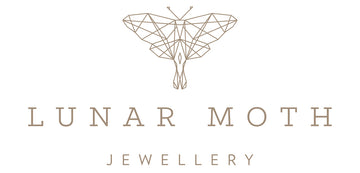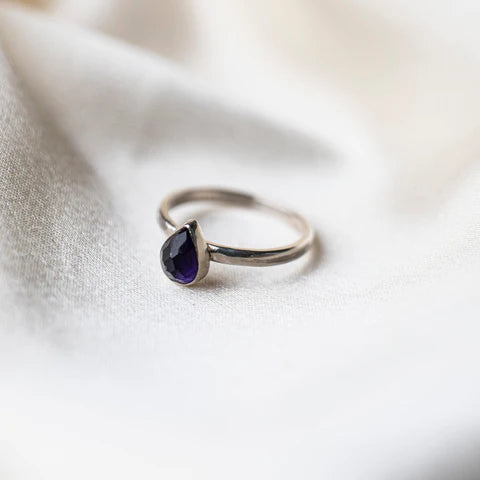Introduction
Welcome to Lunar Moth Jewellery, a brand that embodies more than just the creation of visually stunning pieces. Here, we are deeply committed to sustainable practices that make a positive impact on both the environment and society.
The jewellery industry is under the spotlight in a world that is becoming increasingly conscious of the ecological and ethical implications of consumer choices. This blog post aims to delve into the critical issue of sustainability in the jewellery industry, exploring why it's not just a trend but an urgent necessity.
The Current State of the Jewellery Industry
The jewellery industry has long been synonymous with opulence and grandeur. However, this glamour often overshadows the less-than-sparkling aspects of producing these luxurious items. From the extraction of precious metals like gold and silver to the intricate craftsmanship that goes into each piece, the journey of a single piece of jewellery is fraught with environmental and ethical challenges.
Carbon Footprint
When we talk about the carbon footprint of the jewellery industry, it's essential to consider the entire supply chain. Traditional methods of gold mining are not only energy-intensive but also highly detrimental to the environment. The extraction process involves the use of harmful chemicals like cyanide, which can contaminate water sources. Additionally, the energy required for these processes often comes from fossil fuels, contributing significantly to greenhouse gas emissions and climate change.
Poor Working Conditions
The ethical implications of the jewellery industry extend beyond environmental concerns. Many workers involved in extracting and processing raw materials are subjected to abysmal working conditions. Low wages, lack of safety measures, and exploitative labour practices are rampant. In some cases, child labour and forced labour are employed, raising severe ethical questions about the human cost that goes into creating a single piece of jewellery.
Armed Conflict
The term "conflict minerals" has become increasingly prevalent in discussions about the ethical sourcing of materials in the jewellery industry. Precious metals and gemstones like diamonds have been linked to armed conflicts and civil wars, particularly in regions like Africa. These conflicts result in loss of life, human rights abuses, and long-term social and economic instability. The revenue generated from the sale of these "blood diamonds" or conflict minerals often funds further violence, creating a vicious cycle.
Why Sustainability Matters
The Environmental Imperative
The environmental repercussions of the traditional jewellery industry are far-reaching and cannot be ignored. Air pollution, for instance, is not just a localised issue affecting the immediate vicinity of manufacturing plants. It has global implications, contributing to the greenhouse gases that exacerbate climate change.
Moreover, pollutants like sulfur dioxide and nitrogen oxides can lead to acid rain, devastatingly affecting aquatic life, forests, and even architecture. The health impacts are equally alarming, with pollutants causing a range of respiratory and cardiovascular diseases. In essence, the environmental imperative for sustainability is not just about protecting the Earth; it's about safeguarding human health and well-being.
The Ethical Dimension
When we talk about the ethical dimension of sustainability in the jewellery industry, we're delving into a complex web of human rights, labour practices, and social justice. Ethical sourcing is not a mere checkbox but a comprehensive approach that scrutinises every aspect of the supply chain. This includes the mining or production phase and the retail and post-consumer stages. Brands that commit to ethical sourcing avoid the pitfalls of "blood diamonds" or conflict minerals and ensure fair labour practices, such as equitable wages and safe working conditions. In a world increasingly concerned with social justice, the ethical dimension of sustainability is more relevant than ever.
The Economic Rationale
Sustainability is often viewed through the lens of moral and environmental responsibility, but it also has a compelling economic rationale. Consumer behaviour is undergoing a seismic shift, with a growing number of people willing to pay a premium for products that align with their values. This trend is particularly evident in the jewellery market, where sustainability is becoming a key differentiator. Brands that invest in sustainable practices are not just making an ethical statement but also positioning themselves for long-term economic success.
Sustainable Materials and Practices
Recycled Metals
The use of recycled metals like gold and silver is a significant step toward reducing the jewellery industry's environmental footprint. Unlike new mining, which involves extensive land disruption and chemical usage, recycled metals are a much cleaner option. They eliminate the need for additional mining and provide a new life for metals that might otherwise end up as waste. Brands like Lunar Moth Jewellery are pioneering this approach, offering a range of stunning pieces crafted from recycled materials.
Lab-Grown Diamonds
The introduction of lab-grown diamonds has revolutionised the jewellery industry, offering a viable alternative to traditionally mined diamonds. These diamonds are created in controlled environments, eliminating the need for disruptive mining practices and the ethical concerns associated with conflict diamonds. Moreover, lab-grown diamonds are often less expensive than their mined counterparts, making them an attractive option for the budget-conscious consumer who wants to maintain ethics and quality.
Sustainable vs. Raw Materials
Choosing sustainable materials goes beyond just recycled metals or lab-grown diamonds. It extends to every aspect of production, including the packaging. Sustainable materials are those that have been sourced responsibly, have a low environmental impact, and can be recycled or biodegraded. By opting for jewellery made from these materials, consumers are not just making an ethical choice; they are contributing to a larger movement aimed at reducing the industry's environmental impact.
Role of Consumers
Driving Change Through Choices
The power of consumer choice in shaping industries cannot be overstated, and the jewellery industry is no different. Every time a consumer chooses to purchase a piece of jewellery from a sustainable brand, they are effectively casting a vote for a more ethical and environmentally-friendly world.
This consumer-driven demand is not a fleeting trend but a transformative force that is compelling the jewellery industry to reevaluate its practices and align them with sustainable values. Moreover, this shift is not limited to a specific demographic or region; it's a global phenomenon. Consumers worldwide are becoming increasingly conscious of their impact, making sustainability a universal value that transcends borders.
The Importance of Education
While consumer choice is a potent tool for change, its impact is magnified when backed by informed decisions. Unfortunately, the complexities of the jewellery industry, from sourcing to production, are often not common knowledge. Brands, influencers, and educational platforms have a significant role to play in disseminating this information.
In fact, several organisations and platforms offer comprehensive guides and certifications that help consumers make informed decisions. These resources often break down complex issues like carbon footprint, ethical sourcing, and labor practices into easily digestible information, empowering consumers to make choices that align with their values.
The Rise of Ethical Consumerism
Ethical consumerism is not just a buzzword or a marketing gimmick; it's a burgeoning movement that is gaining momentum across various industries, including jewellery. This movement is supported by a plethora of online tools and apps that help consumers verify a brand's sustainability claims.
From browser extensions that provide sustainability ratings to mobile apps that trace the origin of materials, technology is playing a crucial role in promoting ethical consumerism.
Lunar Moth Jewellery
In any discussion about sustainability in the jewellery industry, it's essential to spotlight brands that are setting a positive example. Lunar Moth Jewellery stands as a shining beacon in this regard, demonstrating that luxury and ethical responsibility can indeed go hand in hand.
Stunning Sterling Silver Sapphire Ring
One of the standout pieces in Lunar Moth Jewellery's collection perfectly illustrates the brand's unwavering commitment to sustainability. This Sapphire Ring is crafted from recycled metals and a responsibly sourced gemstone. It serves as a compelling testament to the possibility of merging luxury with ethical responsibility.
Another remarkable example is a Russian Ring necklace that is not just a piece of jewellery but a statement of values. It captures the essence of beauty while embodying Lunar Moth Jewellery's dedication to ethical sourcing and the use of recycled materials.
Citrine Rosecut Sterling Silver Ring
Lunar Moth Jewellery's innovation in sustainable design is showcased in a particular ring that utilises sustainable materials without sacrificing an iota of aesthetic appeal or quality. It's a prime example of how sustainability and luxury are not mutually exclusive but can complement each other beautifully.
Aquamarine Sterling Silver Ring
Even in their smaller pieces, Lunar Moth Jewellery makes a significant impact. A specific item in their collection, crafted from recycled materials and sourced through ethical channels, is a perfect choice for the conscious consumer looking to make a difference with their purchases.
Hammered Sterling Silver Bangle
Finally, an intricate bracelet from Lunar Moth Jewellery serves as a vivid reminder that sustainable practices can yield extraordinary results. The meticulous attention to detail and a steadfast commitment to sustainability make this piece a standout in their collection.
Conclusion
As we've explored in this comprehensive guide, sustainability in the jewellery industry is not just a trend or a marketing strategy; it's an urgent necessity. The environmental, ethical, and even economic implications of our choices as consumers are far-reaching. From the carbon footprint of gold mining to the ethical dilemmas surrounding conflict minerals and poor working conditions, the traditional jewellery industry has much to answer for.
However, the tide is turning. A growing awareness among consumers, fueled by education and the rise of ethical consumerism, is driving significant changes in the industry.
Brands like Lunar Moth Jewellery are leading the way, proving that it's possible to offer luxurious, beautiful pieces without compromising on ethical and sustainable practices.
So, what can you do as a consumer? The first step is to become educated. Understand your choices' impact and seek brands that align with your values.
Look for certifications, read up on a brand's sourcing practices, and don't hesitate to ask questions. Your choices have power—use it wisely.
As you consider your next jewellery purchase, we invite you to explore Lunar Moth Jewellery's collection of sustainable and ethically sourced pieces. Whether you're looking for a stunning new ring, a timeless necklace, or a pair of elegant earrings, you'll find that luxury and ethics can indeed coexist beautifully.
Ready to make a difference with your next jewellery purchase? Explore Lunar Moth Jewellery's sustainable collection today and be a part of the change you wish to see in the world.

